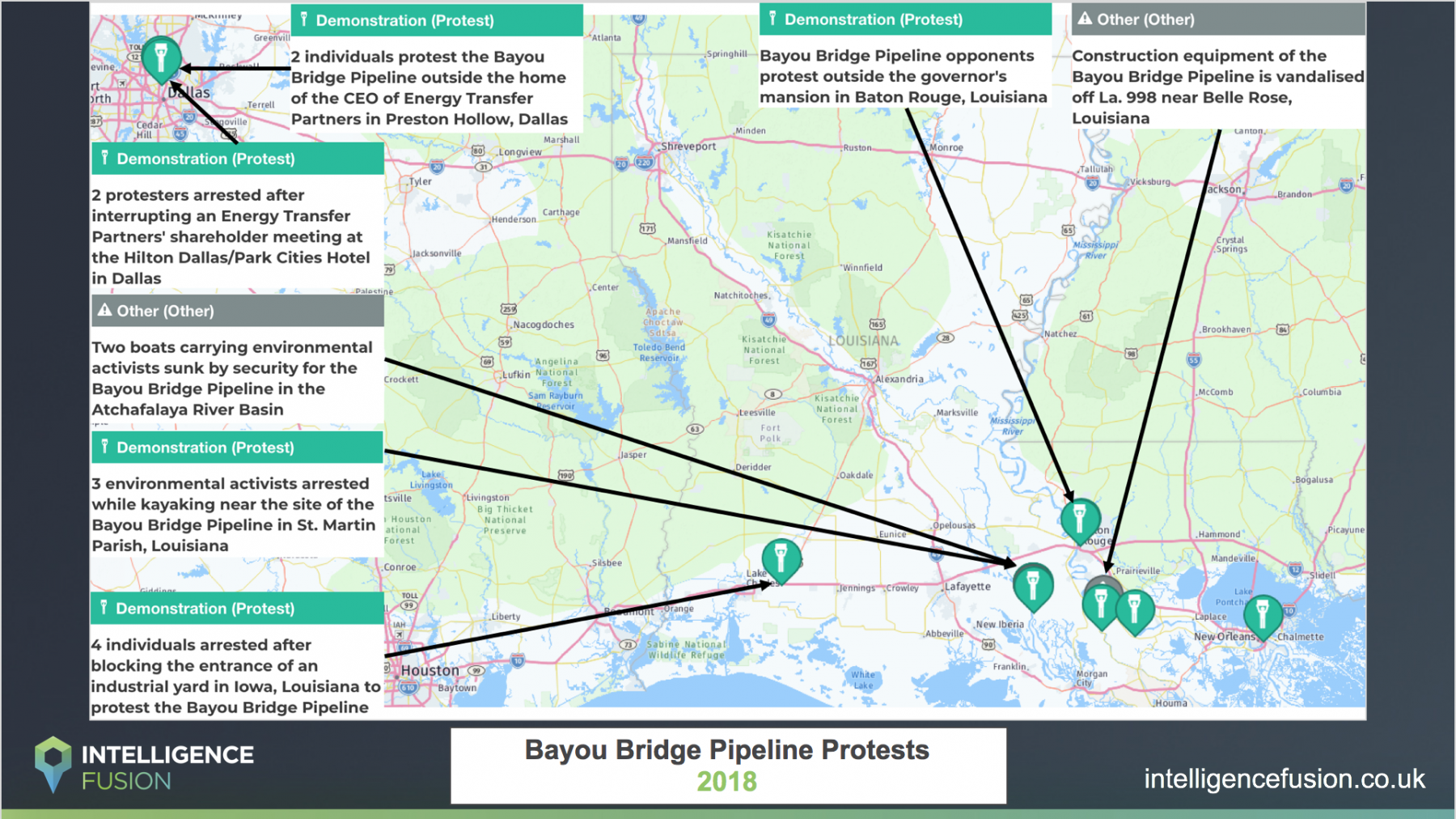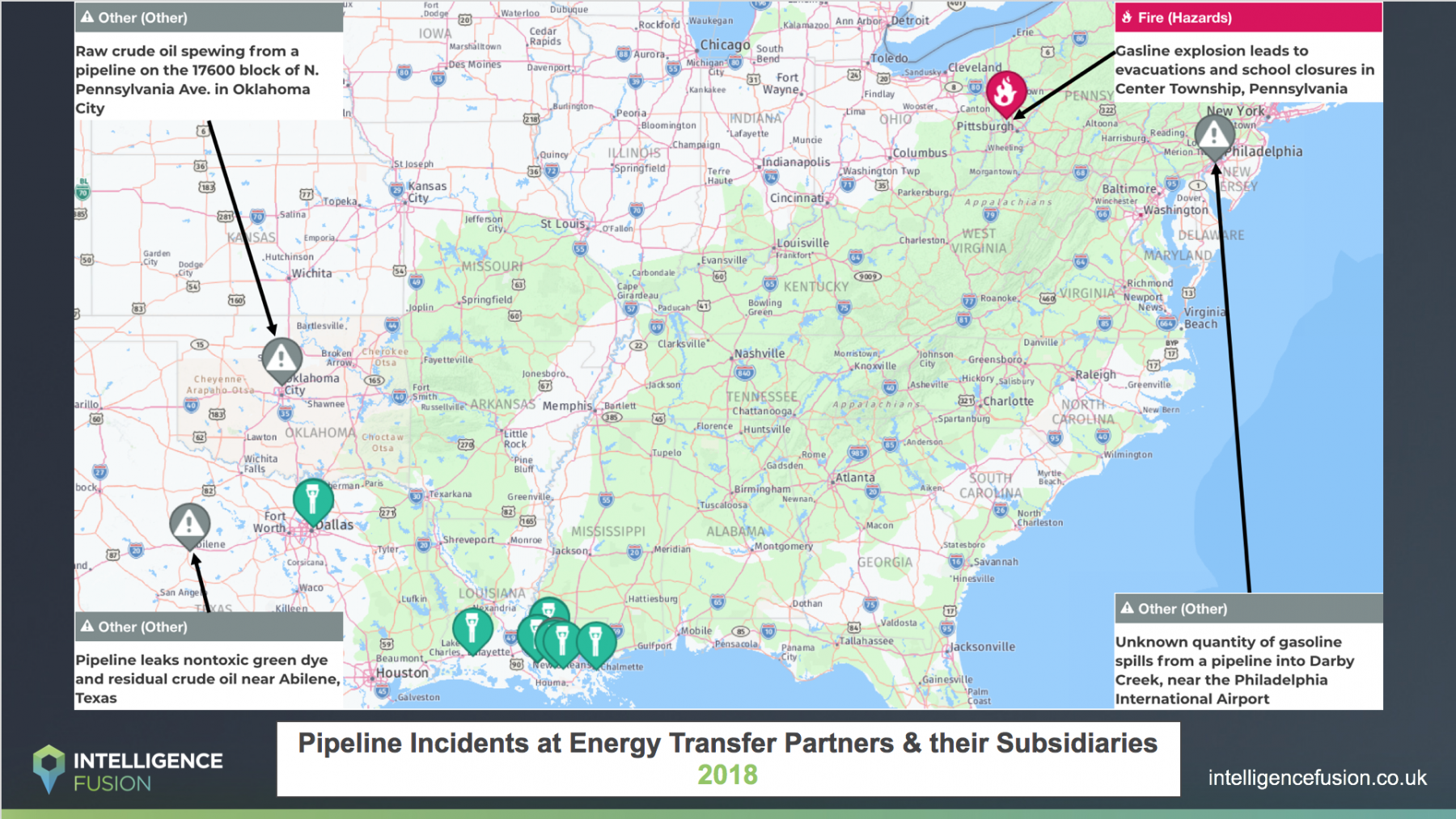Protesting the Bayou Bridge Pipeline in Louisiana
On October 18th, 2018, two protesters were arrested at a hotel in North Dallas after they interrupted a shareholders meeting of Energy Transfer Partners, an oil and gas company which is known for the Bakken pipeline, known as the Dakota Access Pipeline, whose construction was marred by protests near the pipeline’s construction site along the Cannonball River near the Standing Rock Reservation in North Dakota in 2016-2017. The two protesters, along with dozens more protesting outside the hotel and in the lobby, were reportedly protesting the Bayou Bridge Pipeline Phase II, which stretches from Lake Charles, Louisiana to St. James, Louisiana. In addition to the protest outside the shareholders’ meeting, at least two protesters gathered outside the home of the CEO of Energy Transfer Partners, also in Dallas. These acts of protest are only the most recent in a number of incidents regarding the pipeline’s construction, which is planned to be finished by the year’s end after the timeline was amended due to legal challenges.
The Bayou Bridge Pipeline
The Bayou Bridge Pipeline Phase II is a crude oil pipeline stretching 162.5 miles between Lake Charles and St. James in Louisiana, which was announced in 2015 through a joint venture between Energy Transfer Partners, Phillips 66 and Sunoco Logistics Partners LP, in which Energy Transfer would serve as the operator. The pipeline passes through 11 parishes and the Atchafalaya Basin, which is the largest wetland and swamp in the United States. The project is to connect the hub of the oil and gas industry in Texas to oil refineries in Louisiana before it can be exported. Construction of the pipeline was approved in 2017 and began in 2018, despite local communities impacted by the project wanting further environmental impact studies done, as well as demanding an evacuation route for residents of St. James, Louisiana, who are surrounded by refineries and pipelines. Phase I of the project was a pipeline from Nederland, Texas to Lake Charles, Louisiana and it was put into service in 2016.
Protests at the Bayou Bridge Pipeline
Protesting the Bayou Bridge Pipeline construction initially began in the courts, but have since evolved, and since July a growing number of environmental activists have taken to the Atchafalaya Basin to physically try and slow the construction of the pipeline. The main group operating in Louisiana, attempting to stop the Bayou Bridge pipeline, is the L’Eau Est La Vie (Water is Life) group. The protestors have slowed or blocked the construction of the pipeline through non-violent acts such as chaining themselves to machinery, kayaking near the construction site, and putting tents in trees near where workers are clearing a path for the pipeline. A number of protesters have been arrested for these acts, and in some cases in the process of questionable tactics, such as when security personnel on fan boats were reported to have blown kayakers closer to the pipeline in order to be given a reason to arrest them. Additionally, in October, two boats carrying protesters and some members of the media were sunk after security personnel of the pipeline allegedly sped by causing a wake leading to the protestors’ boats taking on water and sinking. No one was hurt in the incident.

In addition to the protests in St. Martin and St. James parishes in Louisiana, members of the group as well as their allies have protested outside the headquarters or branches of several banks, as well as recruitment events run by these banks, who are linked to funding Energy Transfer Partners, responsible for the pipeline. These banks have included Bank of America, Morgan Stanley, Union Bank, Citi Bank, and Wells Fargo among others. Protests, whether in Louisiana or at the banks, have remained peaceful. However, there have been reports of an act of vandalism against construction equipment, as well as vandalism against the vehicles of some of the protestors. There are no reports of arrests having been made in connection to either, and the act of vandalism on the construction equipment has not specifically been linked to the main group of protesters.
New Law Targeting Protesters
In order to combat pipeline protesters, the Louisiana Legislature this year passed Act 692 which increased the penalty from a misdemeanour to a felony for trespassing at sites deemed ‘critical infrastructure’. The act is similar to legislation passed or looking to pass in other states that have seen similar protests since the Dakota Access Pipeline protests. The penalty for trespassing may include up to 5 years in prison and up to a USD 1,000 fine, or both. Penalties increase if the individual or individual is deemed to have criminally damaged anything at the site. Of significant importance is also the language involved in the bill that criminalizes conspiracy to trespass or conspiracy to commit damage.
The Act defines critical infrastructure as all structures, equipment and other property located at or on chemical manufacturing facilities, refineries, electrical power generating facilities, electrical substations (transmission and distribution), water intake structures and water treatment facilities, natural gas transmission compressor stations, LNG terminals and storage facilities, natural gas and hydrocarbon storage facilities, transportation facilities such as ports, railroad switching yard and trucking terminals. A new addition made to the list in this Act was pipelines. Additionally, the Legislature added that under ‘critical infrastructure’ lay any site where the construction or improvement of any facility or structure in the aforementioned list is occurring. The Act came into effect on 1st August 2018, and several arrests have since been made in the area of the Bayou Bridge Pipeline, but the outcome of those arrests have yet to take place.
What Next?
While the completion of the Pipeline Phase II will likely be completed by the end of the year despite the Bayou Bridge protests, there will continue to be protests whether locally or at other sites in the United States where the environment is put at risk by oil, gas, and other energy companies such as Energy Transfer Partners. Energy Transfer Partners has other pipelines and projects in the United States, and theirs and their subsidiaries’ records in regard to incidents at their infrastructure will likely lead to environmental activists protesting any new projects that could especially endanger waterways. In 2018, some of these incidents have included a pipeline gas pipeline explosion north of Pittsburgh in September; a leak at a pipeline in Oklahoma City in May; a pipeline leak into a creek south of Philadelphia in June; and most recently a pipeline leaked a non-toxic dye and residual oil during a hydrostatic test at a pipeline near Abilene. These types of incidents encompass some of the concerns that protestors have when attempting to block pipelines from passing near their communities or near water sources.

Climate change and the protection of the environment is now a mainstream topic. Protest marches like the People’s Climate Movement, which took place in April 2017 and saw hundreds of thousands of people march at hundreds of locations across the United States in protest of President Trump’s administration’s environmental policies, will continue as the populace puts further emphasis on issues regarding the environment. The Trump administration’s environmental agenda has seen the United States pull out of the Paris climate accords, push for an increase in the use of fossil fuels, and working to reverse a number of former-President Obama’s policies and regulations regarding the reduction of carbon emissions and the use of clean renewable energy. The agenda of the administration has received pushback from a large segment of the population, as well as local and state leaders in some areas of the country. This has been seen in the form of the Global Climate Action Summit in September 2018, hosted by California Governor Jerry Brown, and bringing in elected leaders and non-state actors to make commitments to fighting climate change. While these types of events are supported by government officials and take place within the public and media eyes, there are a number of other initiatives such as protesting the Bayou Bridge Pipeline, that do not receive the same support.
However, since the Dakota Access Pipeline protests in North Dakota in 2016-2017, the actions of environmental activists such as those protesting on a smaller scale nearer to the projects, and the responses by local authorities and law enforcement should be watched in order to see the emerging threats that each side faces. While some protests may see physical damage to an energy company’s infrastructure by protestors, the bulk of protesting sees non-violent tactics being used. Energy companies and their allies are more likely to see a financial impact based on work stoppages caused by non-violent protests rather than financial impacts caused by vandalized equipment or infrastructure. Additionally, while energy companies have largely been immune to reputational repercussions due to the amount of revenue they generate and the pull they may have with the local authorities, their allies may not be so immune.
In regard to protests of pipeline construction, such as the Bayou Bridge Pipeline protest, more and more protests, albeit small in scale, have taken place at the institutions financing the energy companies. Some individuals have also closed their bank accounts at these institutions as a sign of protest. While a few individuals closing their bank accounts to protest a pipeline may not make a difference to a large bank like Bank of America or others, we have previously seen calls for boycotts of companies on a range of other issues such as gun control, which has led to retail chains not selling weapons anymore or large companies removing advertising on television shows linked to the negative comments on gun control student-activists. There have already been campaigns held for government and pension funds and universities to divest from fossil fuel companies, and therefore it is not far reaching that protests could, if large enough, impact allies of those same companies.
On the side of protestors, they have already been faced with new legislation being enacted in several states where large pipeline projects such as the Dakota Access Pipeline, which would curtail their activities and increase the penalties they face in case of arrest, showing the over-criminalization of protestors in cases of environmental activism. They have also face heavy handed tactics by local law enforcement and private security companies, as seen in North Dakota with the use of the private security company TigerSwan and in Louisiana where local probation and parole officers were working a second job for security contractors of Energy Transfer Partners while using and wearing state government resources. They also potentially face these same companies gathering intelligence on their movements and activities on social media and sharing that information to the energy companies. Finally, they face legal battles against energy companies and the government in which the odds are not in their favour. In October, a judge in Oregon delayed a lawsuit brought against the government by 21 children and young adults which hoped to force the government to act against climate change. The lawsuit was delayed until the Supreme Court could decide whether to dismiss the case before trial, with the Justice Department arguing it could cause irreparable damage to the government.
While significant challenges are faced by protesters, the likelihood that these protests subside is small. The last decade has seen a surge of activism on a range of issues, and the environment is one of them. While most protests remain small in scale such as the Bayou Bridge Pipeline protest, the tree-sitters in West Virginia and Virginia, or protests against the Enbridge Line 3 replacement in Minnesota, the possibility of larger protests such a repeat of the Dakota Access Pipeline protests in North Dakota is not far-fetched. Large scale occupations of development projects, whether for environmental causes or otherwise, have been seen in France, most notable with the Norte-Dame-des-Landes Airport ZAD, as well as in Germany and Russia among others. Some of these protests have lasted for years and have even been successful in stopping some of the projects. If protests in the United States evolve into large scale occupations such as in these European countries, the law enforcement response, particularly with the militarization of the police forces, is likely to be heavier handed.
Areas for Intelligence Fusion to Explore:
- The role of local law enforcement and private security companies against environmental protests
- The links between local authorities and law enforcement with some energy companies
- The evolution of environmental activism in the United States
- Incidents at oil and gas infrastructure, and the environmental impact they have

